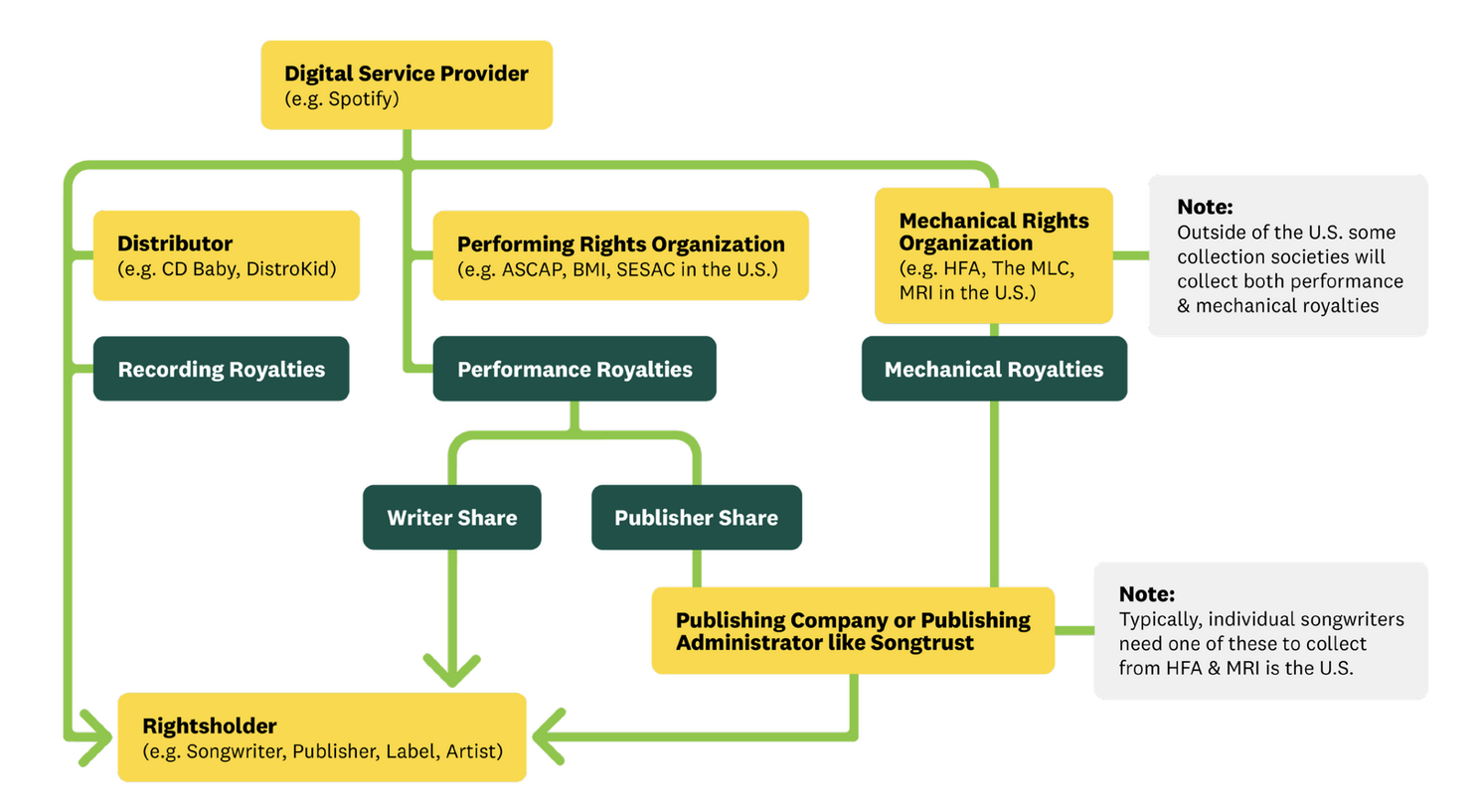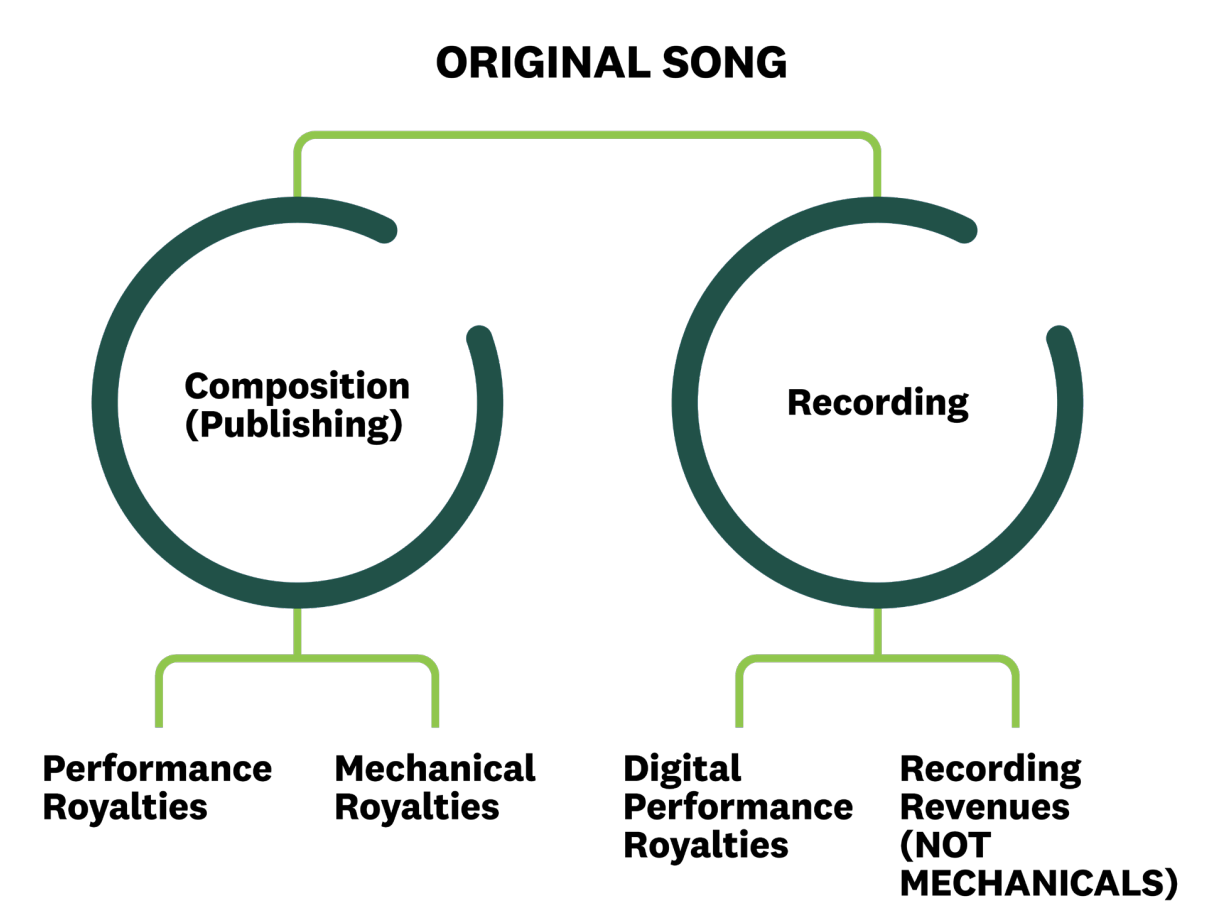Blockchain and web3 can help musicians by giving back ownership over the distribution of their music and copyrights management.
But in order to understand where web3 can add value, it's important to understand first how artists get paid today in the traditional music industry landscape.
How Royalties (Roughly) work in the Music Industry
Royalties are split in two categories, each split into another two.
Spotify and other Digital Service Providers (DSP) pay a series of royalties when a song is played / streamed. These include Recording, Performance and Mechanical royalties.
Recording royalties refer to the actual master recording that is streamed. These are usually paid to a Distributor and then to the Artist (in case of a self-release) or a record label which then pays the artist based on their contract.
Performance royalties refer to the composition behind the artistic work. These are collected by Performance Rights Organizations and then split into two “shares” — The Writer Share is paid directly to the artist and the Publisher Share to a Publishing Administrator, and then a portion of that can go to the artist, according to the corresponding Publishing contract.
Mechanical royalties refer to specific revenue that comes from sales of physical copies and non-interactive streaming (Pandora, SiriusXM). These are collected by MROs in each country and paid to the artist through their Publishing Administrator.


Source: How Spotify Streams Turn Into Royalties
-
Artists are often unaware of all these different types of royalties and many miss out on uncollected royalties because they didn't sign up with the corresponding collection agencies and registered their work.
-
Even for artists tracking their work with collection agencies, royalty payouts can easily take several months.
-
Depending on the entity collecting royalties for each artist, many won't payout until a minimum threshold is met (usually between $50 - $100).
-
Artists often receive limited data to analyze their earnings. They lack detailed insights into which platforms are most profitable, the revenue per stream, and the income generated per listener. Their success largely depends on the quality of the underlying analytics provided by these platforms.
How can Blockchain and Web3 can help?
Instant Payments, Control over Pricing and Packaging
One of the advantages of web3 platforms is the new ways they’ve created to allow artists to distribute their music with fans in innovative ways:
-
Selling music as NFTs on platforms like Foundation or ZORA gives artists the opportunity to set their own rules when it comes to pricing and packaging. How many versions of a new single they sell to super fans and what price they sell it to.
-
Selling a limited number of mints to a new single on sound.xyz. Fans become supporters claiming a seat on the track by minting an NFT on the platform, which gives supporters the right to leave a comment on the track and gain early access to new mints from the same artist in the future. This is a great way for artists to create a strong connection with their fan base, offering a front row VIP seat to new music.
-
Offering to share a portion of web2 royalties via NFTs sale. Royal.io has an interesting model that allows super fans to mint NFTs and invest in the future of music by receiving a share of future streams.
-
Putting your music on Audius, available for mass streaming. Think of Spotify’s model but on web3. sound.xyz is also providing an easier way to discover and stream music through their mobile app.
When artists are distributing on these platforms, they get instant access to funds raised from mints and streams of their releases and know exactly who is supporting their music. They can go back to their fans and keep them in the loop for when they drop the next single.
Future Opportunities
Web3 is still in its early stages, with vast untapped potential for the creative industries.
Streaming
-
Artists getting paid for streaming on web3 — Today, a lot of the streaming made on web3 doesn't issue a payment to. It’s still early, but one option to accomplish this is to add a small charge linked to streaming tracks on these platforms. For example, listeners on Audius could opt-in to buy a regular amount of $AUDIO (the digital token used on the platform) each month and spend it on streaming. Instead of a fixed price for a monthly subscription, listeners can pay according to how much they listen.
-
Pay-per-stream is compatible with minting. —> Artists raise money by minting a single in these platforms to a group of super fans, and separately, they collect royalty payments with streaming. This opens up interesting possibilities, like offering collectors a % of streaming royalties for supporting tracks early.
-
web2 streams as Fungible Tokens: Another (less likely) alternative is to represent existing web2 streams with Fungible Tokens so artists can get paid daily for regular web2 streams, rather than in months. But this would still need to be figured out from a technical perspective. Assuming a fungible token is "transacted" every time a song is streamed, can the blockchain support such real-time transaction volume? Perhaps, at first, this can be solved with a hybrid model between what’s available today in web2 and web3 and bundle all these streams and then generate FTs and issue payouts once a week/month. This gap will close as blockchain technology improves.
Composition
-
Composition is a big aspect of music and creative media, the elements protected by Copyright. In the traditional web2 space, the composition of existing music work used in new creative media earns royalties when the new piece is streamed/sold/performed. We should think of a model that honors that concept in web3, without limiting the fast adoption or use of new platforms.
-
Artists can sell rights to commercial use of their music as an NFTs so others can remix and use the original composition on their own tracks without having to pay the original artist anything after the remix has been minted.
-
Alternatively, remixes sold as Minted NFTs could have a link to a Fungible Token that represents the original Composition behind the remix. The same could be used for streaming remixes. The FT ultimately represents the right-of-payment to the artist of the original work.
-
What happens with all the music already out on web3? Can we possibly implement fingerprinting technology that runs on the blockchain to tag existing work made based on existing music?
I’m excited about the ways creative work can be shared, consumed and monetized on web3 with a focus on honoring creators and giving them more flexibility on how music is distributed. Things are evolving fast, and I believe everything we’ve seen so far is just the beginning. I'll be publishing a second article that explores options to tackle Music Fingerprinting in the World of AI.
